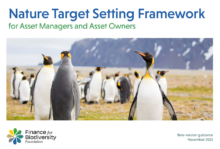The Finance for Biodiversity (FfB) Foundation launches the “Nature Target Setting Framework for Asset Managers and Asset Owners” during a webinar with David Cooper (Acting Executive Secretary CBD Secretariat) and the FfB members on 30 November 2023.
The pioneering framework aims to guide investors in setting targets and steering financial flows in alignment with the mission of the Global Biodiversity Framework to halt and reverse biodiversity loss by 2030.
“This is a milestone initiative under the FfB Foundation. As one of the five commitments of the FfB Pledge, setting targets holds significant importance. Following an inclusive co-creation process involving our target setting working group members and key partners, we take pride in unveiling the resultant framework. We hope this framework will help our signatories and other investors to set nature targets. There is no time to waste in initiating setting targets on nature and taking decisive action on nature”, says Anita de Horde, the Executive Director of FfB Foundation.
Four types of nature targets established by 2026 and 2030
Four types of targets are set out in the framework to create a shared understanding and common language for investors:
- Initiation Targets: analyse exposure to nature-related impacts, dependencies, risks, and opportunities, and embed these considerations in the governance, strategy, and capabilities of the organisation.
- Sectoral, Engagement, and Portfolio Coverage Targets: take action to reduce material drivers of biodiversity loss in priority sectors by setting engagement and stewardship targets and aggregating these at the portfolio level.
Asset managers and asset owners are advised to establish initiation targets to be achieved by 2026 and sectoral, engagement, and portfolio targets to be achieved by 2030 or earlier.
Alignment with the GBF and net-zero frameworks
Developed in collaboration with 44 FfB member organisations from the Target Setting working group, the framework seeks alignment with the Global Biodiversity Framework (GBF) and other frameworks on climate and nature.
Lucian Peppelenbos (Robeco), co-chair of the target setting working group says: “Robeco is pleased to contribute to this pioneering framework, which enables investors to align portfolios with the goal of the Kunming-Montreal Agreement to halt and reverse nature loss by 2030. We are building on existing net zero frameworks and aligning with nature-related initiatives to ensure investors can work towards integrated climate and nature transition plans. We are encouraging all asset owners, asset managers, and other financial institutions, also beyond the signatories of the Finance for Biodiversity Pledge, to use this guide, to help advance it, and to join us in setting targets.”
Beta-version framework focused on listed equity and corporate bonds
The framework focuses on the asset classes listed equity and corporate bonds, but in future iterations, it will incorporate additional asset classes, including sovereign debt.
Charlotte Apps (Fidelity International), co-chair of the Target Setting working group says on the future development of the guide: “This framework is a first beta version to guide investors in getting started with setting targets on nature. Given our world’s environmental challenges, setting ambitious and achievable targets for nature is urgent given that time between now and 2030 is limited. Setting targets provides a critical mechanism of accountability for investors to address nature loss in their stewardship activities and capital allocation decisions. Time is not on our side, so we can’t wait for perfect data or the development of science-based pathways on nature to set targets. We need to start and act now. This beta version of this target setting framework will be iterated, expanded, and updated accordingly to include additional asset classes and align with science-based pathways, as and when they emerge.”
The next version of the guidance document is slated for publication in the first half of 2024, featuring specific KPIs for ten priority sectors. A subsequent version in the second half of 2024 and beyond will expand coverage to additional asset classes and incorporate positive impact targets.
In collaboration with SBTN and UNEP FI, the FfB Foundation emphasises ongoing collaboration. We encourage banks to refer to UNEP FI’s analogous guidance for assistance in establishing nature targets.
About FfB Foundation
The FfB Foundation was set up in March 2021 after the launch of the FfB Pledge in 2020. FfB Foundation aims to support a call to action and collaboration between financial institutions via working groups as a connecting body for contributing signatories and partner organisations. Setting targets is one of the five commitments outlined in the FfB Pledge.







